Related Research Articles
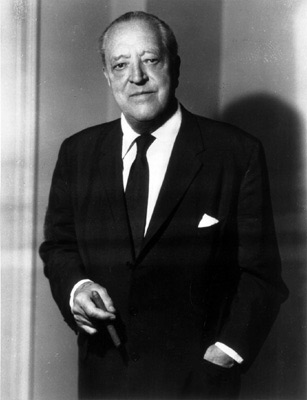
Ludwig Mies van der Rohe was a German-American architect. He was commonly referred to as Mies, his surname. Along with Alvar Aalto, Le Corbusier, Walter Gropius and Frank Lloyd Wright, he is regarded as one of the pioneers of modernist architecture.

A tower block, high-rise, apartment tower, residential tower, apartment block, block of flats, or office tower is a tall building, as opposed to a low-rise building and is defined differently in terms of height depending on the jurisdiction. It is used as a residential, office building, or other functions including hotel, retail, or with multiple purposes combined. Residential high-rise buildings are also known in some varieties of English, such as British English, as tower blocks and may be referred to as MDUs, standing for multi-dwelling units. A very tall high-rise building is referred to as a skyscraper.

The Dakota, also known as the Dakota Apartments, is a cooperative apartment building at 1 West 72nd Street on the Upper West Side of Manhattan in New York City, United States. The Dakota was constructed between 1880 and 1884 in the Renaissance Revival style and was designed by Henry Janeway Hardenbergh for businessman Edward Cabot Clark. The building was one of the first large developments on the Upper West Side and is the oldest remaining luxury apartment building in New York City. The building is a National Historic Landmark and has been designated a city landmark by the New York City Landmarks Preservation Commission. The building is also a contributing property to the Central Park West Historic District.

An apartment, or flat, is a self-contained housing unit that occupies part of a building, generally on a single story. There are many names for these overall buildings, see below. The housing tenure of apartments also varies considerably, from large-scale public housing, to owner occupancy within what is legally a condominium, to tenants renting from a private landlord.
A condominium is an ownership structure whereby a building is divided into several units that are each separately owned, surrounded by common areas that are jointly owned. The term can be applied to the building or complex itself as well as each individual unit within.
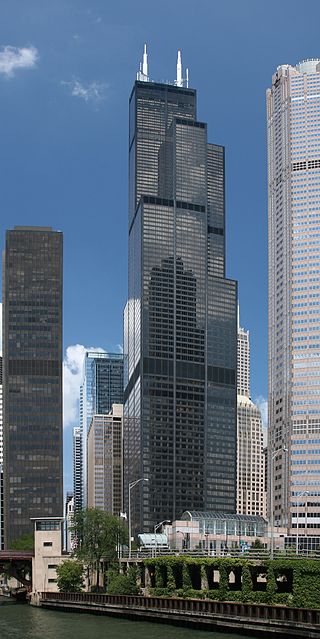
The buildings and architecture of Chicago reflect the city's history and multicultural heritage, featuring prominent buildings in a variety of styles. Most structures downtown were destroyed by the Great Chicago Fire in 1871.
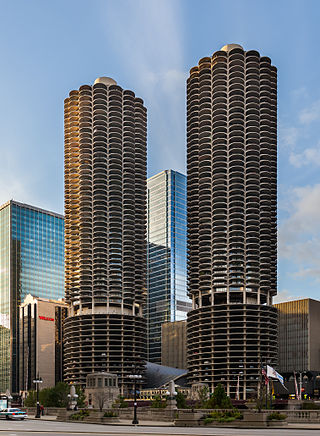
Marina City is a mixed-use residential-commercial building complex in Chicago, Illinois, United States, North America, designed by architect Bertrand Goldberg. The multi-building complex opened between 1963 and 1967 and occupies almost an entire city block on State Street on the north bank of the Chicago River on the Near North Side, directly across from the Loop. Portions of the complex were designated a Chicago Landmark in 2016.
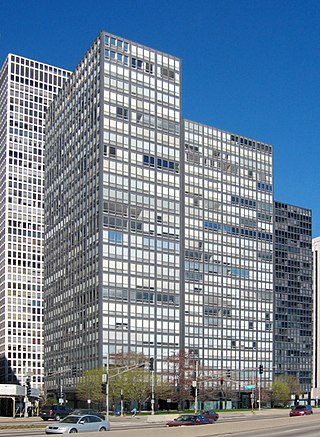
860–880 Lake Shore Drive is a twin pair of glass-and-steel apartment towers on N. Lake Shore Drive along Lake Michigan in the Streeterville neighborhood of Chicago, Illinois. Construction began in 1949 and the project was completed in 1951. The towers were added to the National Register of Historic Places on August 28, 1980, and were designated as Chicago Landmarks on June 10, 1996. The 26-floor, 254-ft tall towers were designed by the architect Ludwig Mies van der Rohe, and dubbed the "Glass House" apartments. Construction was by the Chicago real estate developer Herbert Greenwald, and the Sumner S. Sollitt Company. The design principles were copied extensively and are now considered characteristic of the modern International Style as well as essential for the development of modern High-tech architecture.

Single room occupancy is a form of housing that is typically aimed at residents with low or minimal incomes who rent small, furnished single rooms with a bed, chair, and sometimes a small desk. SRO units are rented out as permanent residence and/or primary residence to individuals, within a multi-tenant building where tenants share a kitchen, toilets or bathrooms. SRO units range from 7 to 13 square metres. In some instances, contemporary units may have a small refrigerator, microwave, or sink.
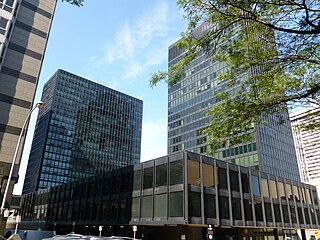
Westmount Square is a residential and office complex located in Westmount, Quebec, Canada. There are two residential apartment buildings and two office buildings. These towers sit atop an underground shopping centre consisting of thirty-five shops. It is located between Saint Catherine Street and De Maisonneuve Boulevard and between Wood Avenue and Greene Avenue. It is connected to Place Alexis Nihon, Dawson College, and the Atwater Metro station by a tunnel.

S. R. Crown Hall, designed by the German-American Modernist architect Ludwig Mies van der Rohe, is the home of the College of Architecture at the Illinois Institute of Technology in Chicago, Illinois.

An apartment hotel or aparthotel is a serviced apartment complex that uses a hotel-style booking system. It is similar to renting an apartment, but with no fixed contracts and occupants can "check out" whenever they wish, subject to the applicable minimum length of stay imposed by the company.

Multifamily residential is a classification of housing where multiple separate housing units for residential inhabitants are contained within one building or several buildings within one complex. Units can be next to each other, or stacked on top of each other. A common form is an apartment building. Many intentional communities incorporate multifamily residences, such as in cohousing projects. Sometimes units in a multifamily residential building are condominiums, where typically the units are owned individually rather than leased from a single apartment building owner.

Willoughby James Edbrooke (1843–1896) was an American architect and a bureaucrat who remained faithful to a Richardsonian Romanesque style into the era of Beaux-Arts architecture in the United States, supported by commissions from conservative federal and state governments that were spurred by his stint in 1891-92 as Supervising Architect of the U.S. Treasury Department.
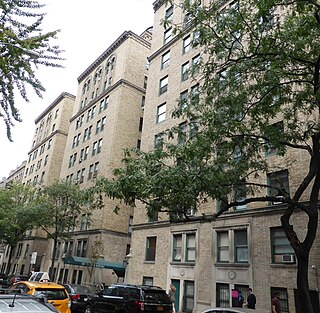
The Whitby is the name of the residential property at 325 West 45th Street in Hell's Kitchen, Manhattan, New York. The Whitby was designed by architect Emery Roth and built by Bing & Bing general contractors. It was originally commissioned as a hotel by The Gresham Realty Company in 1924 and opened for business on October 1, 1924. The building was converted into a residential cooperative in 1988 by Premiere Marketing Services. The 10-story dwelling between Eighth and Ninth Avenues has 215 apartments.
Franklin Pierce Burnham was an American architect. He is best known for his collaborations with Willoughby J. Edbrooke, especially the 1889 Georgia State Capitol. Burnham was also named the Kenilworth Company Architect for Kenilworth, Illinois, and thus designed several of the planned community's original structures. After 1903, Burnham focused his works on California, including a series of twelve Carnegie libraries. Five of his buildings are today recognized by the National Park Service on the National Register of Historic Places, including the Georgia State Capitol, a National Historic Landmark.
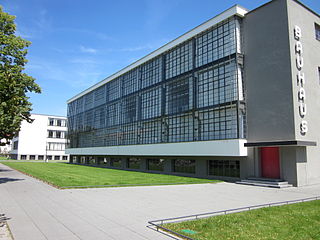
Bauhaus and its Sites in Weimar, Dessau and Bernau is a World Heritage Site in Germany, comprising six separate sites which are associated with the Bauhaus art school. It was designated in 1996 with four initial sites, and in 2017 two further sites were added.
900 910 North Lake Shore are a pair of glass and steel buildings, perpendicular to one another, designed by architect Ludwig Mies van der Rohe, in the Streeterville neighborhood of Chicago. Completed in 1956, they marked the refinement of Mies' highrise building design concept. The buildings are built to a Modernist International style that was considered to be a departure from the dominant aesthetic at the time they were built, and even criticized as too minimal. The "glass houses" are more often appreciated for the views they offer of Lake Michigan and downtown Chicago. The buildings were referred to as “giant mirrors for lake beauty”.

The Arc is a residential development located beside Abercorn Basin in the Titanic Quarter of Belfast, Northern Ireland. The development was constructed between 2007 and 2009. It contains 474 residential properties, a hotel, and a number of retail units, split across three buildings. The name "Arc" is an abbreviation for Abercorn Residential Complex, and also refers to the curved design of the buildings.
Carman Hall is a dormitory owned by the Illinois Institute of Technology.
References
- 1 2 3 4 5 6 7 Altshuler, Joseph (20 July 2018). "Historic Mecca Flats apartment building unearthed in Chicago". The Architect's Newspaper. Retrieved 8 August 2018.
- 1 2 "Building History | The Mecca Apartments". buildinghistory.iit.edu. Retrieved 2018-11-21.
- ↑ Olumhense, Ese (6 August 2018). "Long-demolished World's Fair building unearthed at IIT, tells story of Chicago's racial divide". Chicago Tribune. Retrieved 8 August 2018.
- ↑ Bluestone, Daniel (1 December 1998). "Chicago's Mecca Flat Blues". Journal of the Society of Architectural Historians. Society of Architectural Historians. 57 (4): 382–403. doi:10.2307/991458. JSTOR 991458.
- 1 2 3 4 5 6 "City of Chicago :: Mecca Flat Blues". www.cityofchicago.org. Retrieved 2018-11-21.
- 1 2 3 4 Murphy, Kevin; Willis, Carol; Bluestone, Daniel; Traynor, Kerry; Levine, Sally (2018-07-24). "Remembering America's lost buildings". CNN Style. Retrieved 2018-11-21.
- 1 2 3 "Mecca Flats Artifacts Discovered During Excavation Work! "Shared History: The Mecca Flat Revealed at IIT Architecture". S. R. Crown Hall, Tuesday, August 7, 12:30 pm | PreservationChicago". preservationchicago.org. Retrieved 2018-11-21.
- 1 2 Kukrechtová, Daniela (2009). "The Death and Life of a Chicago Edifice: Gwendolyn Brooks's "In the Mecca"". African American Review. 43 (2/3): 457–472. doi:10.1353/afa.2009.0033. JSTOR 41328621.
- 1 2 Steinkopf-Frank, Hannah (8 November 2018). "Rediscovering Mecca Flats, a Legendary Chicago Apartment Building". www.atlasobscura.com. Retrieved 17 April 2019.